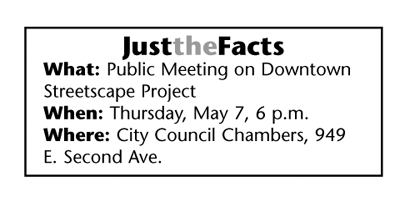|
| ||||
| Improving the downtown experience
by Missy Votel After years of wrangling over a new look for downtown Durango, city officials have settled on a makeover versus a facelift. The plan, known as the Downtown Streetscape Project, will be presented to residents this Thurs., May 7, at 6 p.m. in City Council Chambers. The project, which is scheduled to begin this fall, includes plans for new bike racks, benches, signage, trash cans and trees. It also calls for a replacement of 15 percent of city sidewalks as well as a “signature intersection” at College Drive and Main. The City began looking at revamping downtown in 2005 in light of safety concerns over uneven and cracked sidewalks, explained Director of Public Works Jack Rogers. However, as the City began work on the design, it found many property and business owners were interested in a more comprehensive approach to changing the downtown streetscape. “That led to the hiring of a consultant to work on the Downtown Vision and Strategic Plan,” said Rogers. That plan, which was completed in 2006, recommended a number of changes to improve the business climate and downtown experience, including narrowing Main Avenue, repairing and widening sidewalks, and creating pedestrian “bulbouts” at each intersection. However, many residents balked at the plan as being too ambitious while downtown business and property owners complained of the cost and inconvenience of sidewalk reconstruction. As a result, the city headed back to the table, where it reached a consensus on downtown streetscape improvements. “We decided we weren’t going to narrow the streets and would only repair the sidewalks where they were a hazard,” Rogers said. Fifteen percent of downtown sidewalks fall into this category, and adjacent property owners will be asked to foot half the repair bill. Estimated cost for removal and replacement of 50 feet of sidewalk is $10,000, so property owners would be asked to pay $5,000. However, they can pay off the cost over time. To further mitigate the impacts to businesses, sidewalk work will be done during the shoulder season, construction zones will be confined to one block at a time and businesses will only have to be closed for one 24-hour period, while concrete sets. Aside from sidewalks, the biggest piece of the plan is a “signature intersection” at College and Main. According to Rogers, the goal of is to not only increase pedestrian safety but create a “point of destination” for tourists and locals alike. “A major item of concern for downtown merchants has been pedestrian safety, not just along the sidewalks but in crossing of streets, particularly the intersection of College Drive and Main Avenue,” he said. In order to address the problem, the plan calls for creating a pedestrian square, also known as a “Barnes Dance” for its designer, at the intersection, where traffic stops in both directions and pedestrian are allowed to cross either way or horizontally. The square will also be highlighted with the use of colored, patterned concrete that will both direct pedestrian traffic and provide aesthetic appeal. “The finished product should be something that is appealing and adds to the ambiance of Main Avenue,” said Rogers. “If it works well, we’ll try it at other intersections.” Other specifics of the plan include: • Additional bike racks and the creation of bike parking zones. During warmer months, new bike racks will be installed on side streets to facilitate pedestrian flow on Main Avenue and increase bike parking capacity. The racks will be removed in the winter but those who ride throughout the year can use existing sidewalk racks. • Additional benches. Due to demand, the city plans to add 22 benches along Main Avenue and the side streets between East Second and Narrow Gauge Avenue. • Business directories and wayfinding signage • Increased downtown wi-fi capability using downtown street lights as antennas locations for wireless coverage from 14th to Fifth streets. • Trial run of new solar-powered “compaction” trash cans to collect more trash in a smaller space. • Tree plantings to replace dead, dying or damaged trees. • Clean up of newspaper boxes on city sidewalks. A new ordinance would require box owners to acquire permit from city, with an allotted amount on each block. Requests would be issued on first-come first-serve basis. Provided the city recovers form the current economic downturn, Rogers estimated it will take four years to complete the work at a cost of $3 million. There is $750,000 budgeted for the project in 2009, and the city was recently awarded another $500,000 in a matching grant. The city plans to budget $750,000 per year for 2010-12 as well. Rogers said plans call for beginning work at the south end and moving north. Some features such as the benches and bike racks will occur sooner than the sidewalk replacement. Plans call for the formation of sidewalk districts each year, with assessments varying depending on the cost of construction. The first sidewalk district public hearing would be held this summer for November construction. All affected property owners will be notified of the public hearings. Rogers said the plan is ambitious, and the work will be challenging, but with cooperation of all involved, the effort will be worthwhile. “It will require the city, its contractors and business and property owners working together to accomplish the tasks efficiently so that when we finish we can all be proud of the finished product,” he said. •
|



